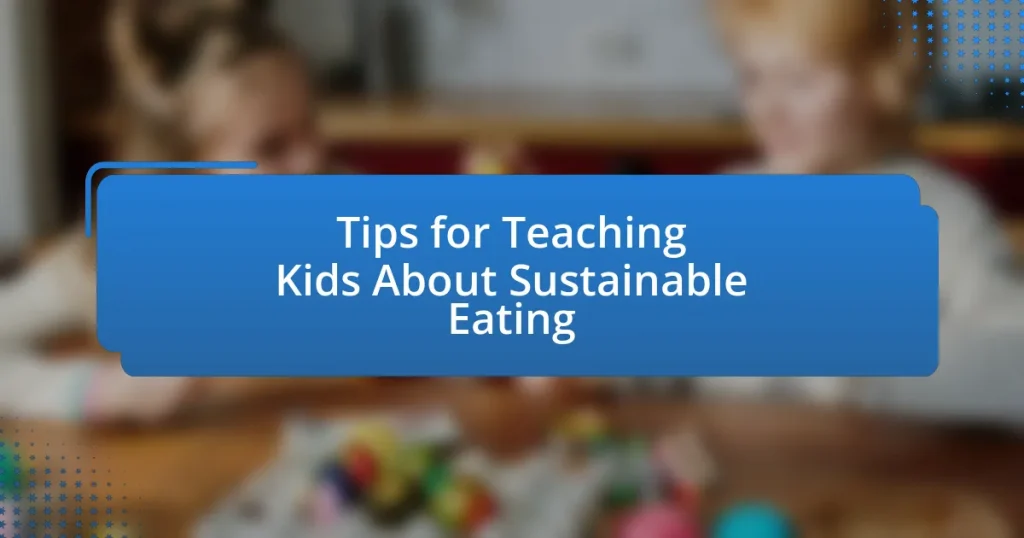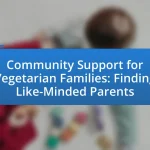Sustainable eating is the practice of selecting foods that are environmentally friendly, promote animal welfare, and support local economies. This article provides essential tips for teaching children about sustainable eating, emphasizing the importance of healthy diets, environmental awareness, and social responsibility. Key topics include the health benefits of sustainable eating for kids, principles of sustainable food choices, and practical strategies for parents to engage children in meal planning and preparation. Additionally, the article highlights resources and community initiatives that can enhance children’s understanding of sustainable food practices.
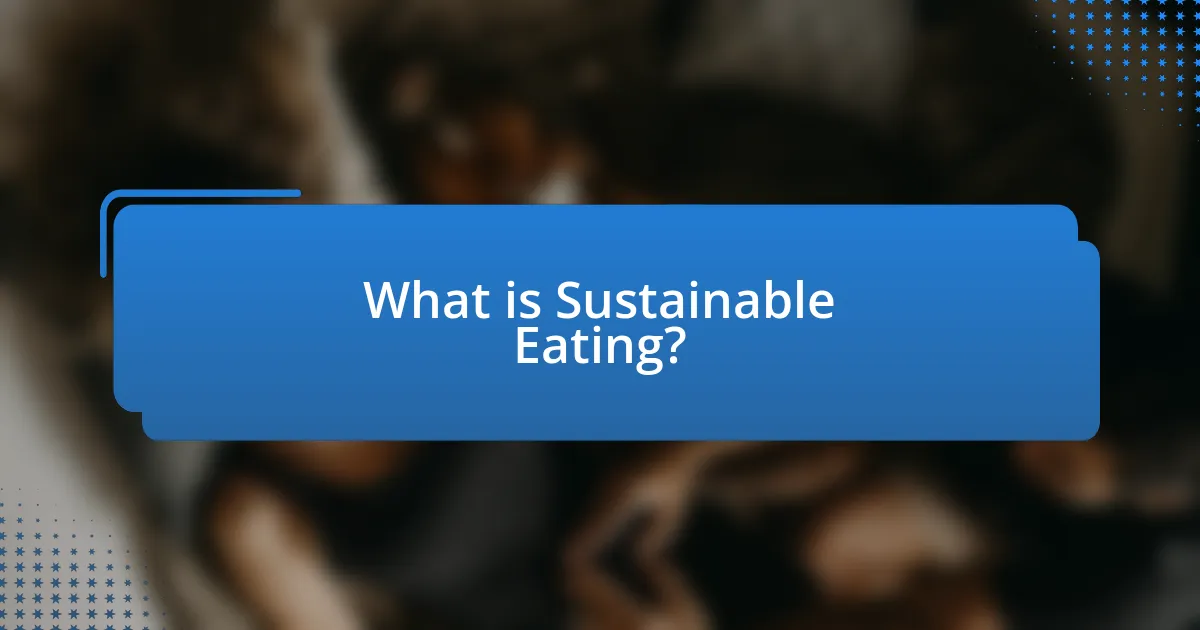
What is Sustainable Eating?
Sustainable eating refers to the practice of choosing foods that are produced in ways that protect the environment, promote animal welfare, and support local economies. This approach emphasizes the consumption of seasonal, organic, and locally sourced foods, which can reduce carbon footprints and minimize resource depletion. Research indicates that sustainable eating can lead to healthier diets and contribute to the reduction of greenhouse gas emissions, as highlighted by the Food and Agriculture Organization, which states that food systems are responsible for approximately 30% of global greenhouse gas emissions.
Why is Sustainable Eating Important for Kids?
Sustainable eating is important for kids because it promotes health, environmental awareness, and social responsibility. By consuming locally sourced, organic, and seasonal foods, children can develop healthier eating habits that reduce the risk of obesity and related diseases. Research indicates that diets rich in fruits, vegetables, and whole grains contribute to better physical and mental health outcomes in children. Additionally, sustainable eating practices help kids understand the impact of food choices on the environment, fostering a sense of stewardship for the planet. For instance, the United Nations reports that food production is responsible for approximately 25% of global greenhouse gas emissions, highlighting the importance of mindful consumption. Teaching kids about sustainable eating equips them with the knowledge to make informed choices that benefit their health and the environment.
How does Sustainable Eating impact the environment?
Sustainable eating significantly reduces environmental impact by minimizing resource depletion and greenhouse gas emissions. This approach emphasizes the consumption of locally sourced, seasonal, and plant-based foods, which require less energy and water compared to industrial farming practices. For instance, a study published in the journal “Nature” found that shifting towards a plant-based diet could reduce food-related greenhouse gas emissions by up to 70%. Additionally, sustainable eating practices promote biodiversity and soil health, as they often involve organic farming methods that avoid harmful pesticides and fertilizers. Thus, adopting sustainable eating habits contributes to a healthier planet by conserving resources and reducing pollution.
What health benefits does Sustainable Eating provide for children?
Sustainable eating provides numerous health benefits for children, including improved nutrition and enhanced physical health. By focusing on whole, minimally processed foods, sustainable eating encourages the consumption of fruits, vegetables, whole grains, and lean proteins, which are essential for a child’s growth and development. Research indicates that diets rich in these foods can lead to better cognitive function and lower rates of obesity, diabetes, and other chronic diseases in children. For instance, a study published in the Journal of Nutrition found that children who consume a diet high in fruits and vegetables have a significantly lower risk of developing obesity-related health issues.
What are the Principles of Sustainable Eating?
The principles of sustainable eating include prioritizing plant-based foods, choosing local and seasonal produce, minimizing food waste, and selecting sustainably sourced animal products. These principles aim to reduce environmental impact, promote biodiversity, and support local economies. For instance, a diet rich in fruits, vegetables, legumes, and whole grains can lower greenhouse gas emissions significantly compared to a meat-heavy diet, as highlighted by research from the Food and Agriculture Organization, which states that livestock production contributes to 14.5% of global greenhouse gas emissions. Additionally, consuming local foods reduces transportation emissions and supports local farmers, fostering community resilience.
What types of foods are considered sustainable?
Sustainable foods include plant-based foods, locally sourced produce, organic foods, and sustainably harvested seafood. Plant-based foods, such as fruits, vegetables, legumes, and grains, require fewer resources and produce lower greenhouse gas emissions compared to animal products. Locally sourced produce reduces transportation emissions and supports local economies. Organic foods are grown without synthetic pesticides and fertilizers, promoting soil health and biodiversity. Sustainably harvested seafood comes from fisheries that maintain fish populations and ecosystems, ensuring long-term viability. These categories of food contribute to environmental health and resource conservation, making them essential for sustainable eating practices.
How can kids identify sustainable food choices?
Kids can identify sustainable food choices by looking for foods that are locally sourced, organic, and seasonal. Locally sourced foods reduce transportation emissions, organic foods are grown without harmful pesticides, and seasonal foods are harvested at their peak, which often means they are fresher and require less energy for storage. Research indicates that consuming local and seasonal produce can significantly lower carbon footprints, making these choices more environmentally friendly. Additionally, kids can learn to read labels to identify certifications such as USDA Organic or Fair Trade, which indicate sustainable practices in food production.
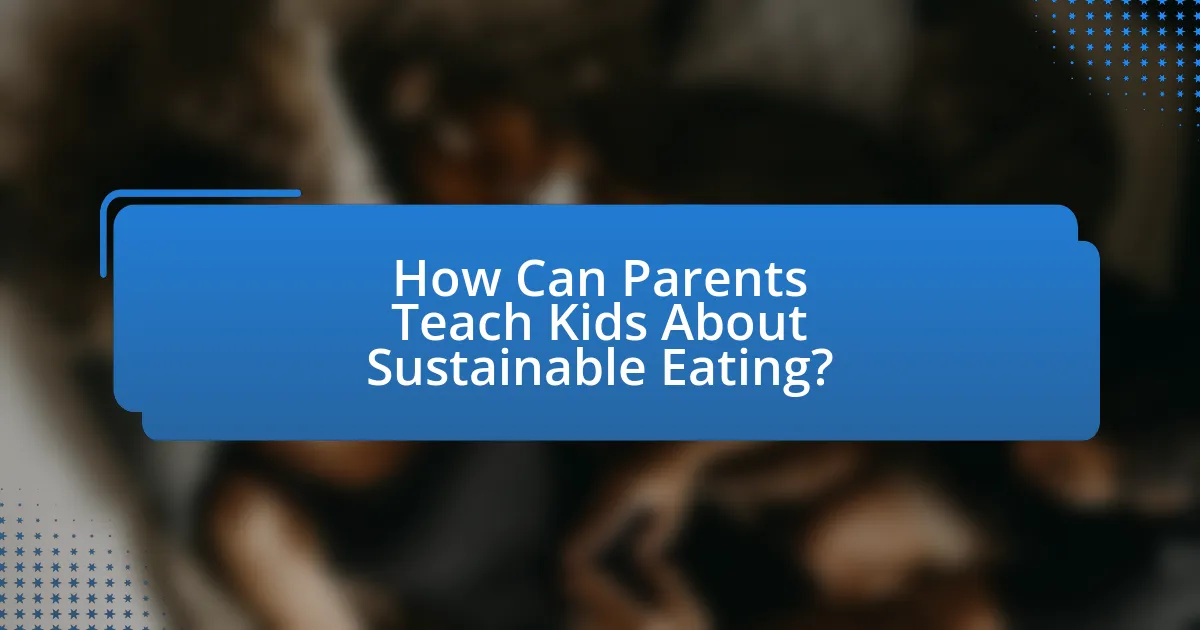
How Can Parents Teach Kids About Sustainable Eating?
Parents can teach kids about sustainable eating by involving them in meal planning and preparation, emphasizing the importance of local and seasonal foods. Engaging children in these activities helps them understand where their food comes from and the environmental impact of food choices. Research indicates that children who participate in cooking and gardening are more likely to make healthier food choices and develop a positive attitude towards sustainable practices. For example, a study published in the Journal of Nutrition Education and Behavior found that children who gardened were more inclined to eat fruits and vegetables. By fostering these experiences, parents can instill lifelong habits of sustainable eating in their children.
What are Effective Strategies for Teaching Kids?
Effective strategies for teaching kids include interactive learning, hands-on activities, and real-life applications. Interactive learning engages children through discussions and questions, fostering critical thinking. Hands-on activities, such as cooking or gardening, allow kids to experience concepts directly, enhancing retention. Real-life applications, like visiting local farms or markets, connect lessons to their environment, making learning relevant. Research shows that experiential learning increases understanding and interest, as evidenced by studies indicating that children retain 75% of what they learn through hands-on experiences compared to 5% through lectures.
How can cooking together promote understanding of sustainable eating?
Cooking together promotes understanding of sustainable eating by allowing participants to engage directly with food sourcing, preparation, and the environmental impact of their choices. When individuals cook as a group, they can discuss and explore the origins of ingredients, such as local versus imported produce, and the benefits of seasonal eating. This hands-on experience fosters awareness of food waste, as participants can learn to utilize leftovers creatively and understand portion sizes. Research indicates that children who participate in cooking activities are more likely to develop healthier eating habits and a greater appreciation for sustainable practices, as evidenced by a study published in the Journal of Nutrition Education and Behavior, which found that cooking classes significantly increased knowledge about nutrition and sustainability among young participants.
What role does gardening play in teaching kids about food sources?
Gardening plays a crucial role in teaching kids about food sources by providing hands-on experience in growing and understanding where food comes from. Engaging in gardening activities allows children to observe the entire lifecycle of plants, from seed germination to harvest, which fosters a deeper appreciation for food production. Research indicates that children who participate in gardening are more likely to make healthier food choices and develop a positive attitude towards fruits and vegetables, as evidenced by a study published in the Journal of Nutrition Education and Behavior, which found that school gardening programs increased students’ consumption of fresh produce.
How can parents incorporate sustainable eating into daily routines?
Parents can incorporate sustainable eating into daily routines by planning meals that prioritize local, seasonal, and organic foods. This approach not only reduces carbon footprints associated with transportation but also supports local farmers and promotes biodiversity. Research indicates that consuming locally sourced foods can decrease greenhouse gas emissions by up to 11% compared to foods transported over long distances. Additionally, parents can involve children in meal preparation, teaching them about the origins of their food and the importance of reducing food waste. By implementing practices such as composting and using reusable containers, families can further enhance their sustainable eating habits.
What are some practical meal planning tips for sustainable eating?
Practical meal planning tips for sustainable eating include prioritizing seasonal and local produce, which reduces carbon footprints associated with transportation. Incorporating plant-based meals into weekly plans can significantly lower environmental impact, as studies show that plant-based diets can reduce greenhouse gas emissions by up to 50%. Additionally, batch cooking and using leftovers effectively minimize food waste, which is a major contributor to environmental degradation. Planning meals around what is already in the pantry can also prevent unnecessary purchases and reduce waste. Lastly, involving children in meal planning fosters awareness and encourages them to make sustainable food choices.
How can families reduce food waste together?
Families can reduce food waste together by planning meals, using leftovers creatively, and involving children in food preparation. Meal planning helps families buy only what they need, reducing excess purchases that often lead to waste. Utilizing leftovers in new recipes encourages children to think creatively about food and understand its value. Engaging kids in cooking teaches them about portion sizes and the importance of not over-preparing meals, which can significantly decrease food waste. According to the USDA, approximately 30-40% of the food supply in the United States is wasted, highlighting the importance of these practices in promoting sustainability.
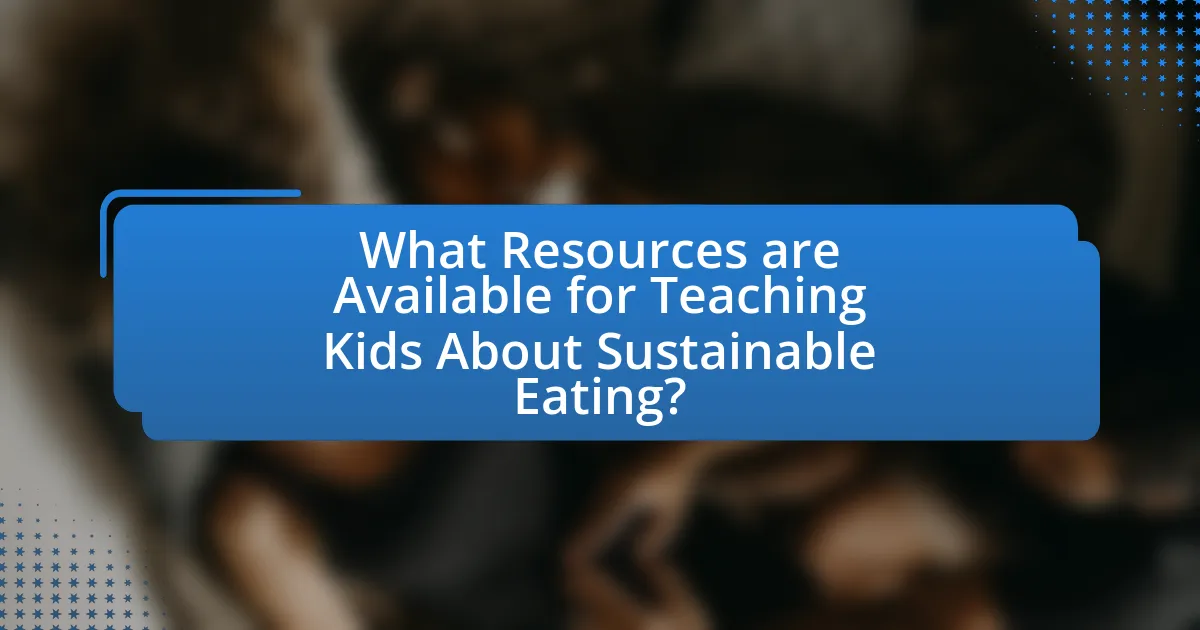
What Resources are Available for Teaching Kids About Sustainable Eating?
Resources available for teaching kids about sustainable eating include educational websites, interactive apps, and hands-on activities. Websites like the USDA’s MyPlate provide guidelines on healthy eating and sustainability, while apps such as “FoodPrint” help children understand the environmental impact of their food choices. Additionally, programs like “Farm to School” connect students with local farms, promoting awareness of where food comes from and its ecological effects. These resources are effective in engaging children and fostering a deeper understanding of sustainable eating practices.
What books and materials can help educate children?
Books and materials that can help educate children about sustainable eating include “The Omnivore’s Dilemma: The Secrets Behind What You Eat” by Michael Pollan, which explains food sources and sustainability in an engaging manner for younger audiences. Additionally, “Eating the Alphabet” by Lois Ehlert introduces children to various fruits and vegetables while promoting healthy eating habits. Educational materials such as interactive workbooks and online resources from organizations like the USDA’s Food and Nutrition Service provide practical activities and information on nutrition and sustainability. These resources collectively enhance children’s understanding of food systems and encourage responsible eating practices.
Which websites offer interactive learning about sustainable eating?
Websites that offer interactive learning about sustainable eating include FoodPrint, which provides resources on sustainable food choices and practices, and the USDA’s MyPlate, which offers interactive tools for healthy eating. Additionally, the website KidsGardening features educational activities related to gardening and sustainable food systems. These platforms engage users through interactive content, quizzes, and educational resources, promoting awareness and understanding of sustainable eating practices.
How can community involvement enhance learning about sustainable eating?
Community involvement enhances learning about sustainable eating by providing practical experiences and fostering collaboration among individuals. Engaging in local food initiatives, such as community gardens or farmers’ markets, allows participants to understand the origins of their food and the importance of sustainable practices. Research indicates that hands-on activities, like growing vegetables or participating in cooking classes, significantly improve knowledge retention and attitudes towards healthy eating. For instance, a study published in the Journal of Nutrition Education and Behavior found that children who participated in community gardening programs showed increased awareness of nutrition and sustainability concepts. This direct engagement not only educates but also builds a sense of responsibility and connection to the environment, reinforcing the principles of sustainable eating.
What local programs or initiatives support sustainable eating education?
Local programs that support sustainable eating education include community gardens, school-based nutrition programs, and local food co-ops. Community gardens, such as those found in urban areas, provide hands-on experiences for children to learn about growing food sustainably. School-based nutrition programs, like the USDA’s Farm to School program, educate students on the benefits of local and seasonal foods while promoting healthy eating habits. Local food co-ops often host workshops and events focused on sustainable food practices, further enhancing community awareness and education on sustainable eating. These initiatives collectively foster a culture of sustainability and healthy eating among children and families.
What are the Best Practices for Encouraging Sustainable Eating Habits in Kids?
The best practices for encouraging sustainable eating habits in kids include involving them in meal planning, teaching them about food sources, and modeling healthy eating behaviors. Involving children in meal planning helps them understand the importance of choosing local and seasonal foods, which can reduce carbon footprints. Educating kids about where their food comes from, such as visiting farms or farmers’ markets, fosters a connection to the environment and promotes appreciation for sustainable practices. Additionally, parents and caregivers should model healthy eating by consuming a variety of plant-based foods, as studies show that children are more likely to adopt similar eating habits when they see adults practicing them.
How can parents model sustainable eating behaviors?
Parents can model sustainable eating behaviors by incorporating local, seasonal, and plant-based foods into their family meals. This practice not only reduces carbon footprints associated with food transportation but also supports local farmers and promotes biodiversity. Research indicates that plant-based diets can lower greenhouse gas emissions by up to 50% compared to meat-heavy diets. By demonstrating these choices, parents can instill values of environmental responsibility and health consciousness in their children, fostering lifelong sustainable eating habits.
What tips can help kids make sustainable choices independently?
To help kids make sustainable choices independently, encourage them to understand the impact of their food choices on the environment. Teaching them to read labels can empower them to select products with minimal packaging and sustainable ingredients. For instance, children can learn to identify local and seasonal foods, which often have a lower carbon footprint compared to imported items. Engaging kids in meal planning and cooking can also foster a sense of responsibility and awareness about food waste. Research shows that children who participate in food preparation are more likely to make healthier and more sustainable eating choices.
